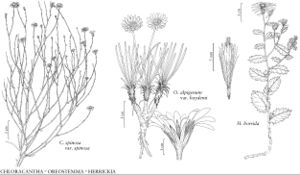Chloracantha
Phytologia 70: 378. 1991.
| Taxon | Illustrator ⠉ | |
|---|---|---|
 | Chloracantha spinosa var. spinosa Oreostemma alpigenum var. haydenii Herrickia horrida | Linny Heagy Barbara Alongi Yevonn Wilson-Ramsey |
Perennials or subshrubs (commonly appearing herbaceous), 50–150 (–250) cm, sometimes glaucous, glabrous or glabrate (forming large clones; stoutly rhizomatous). Stems erect (strict), lateral branches sharply ascending, often modified to thorns. Leaves cauline (early withering); alternate; sessile; blades 1-nerved, oblanceolate, margins entire or rarely with 1–2 pairs of small teeth. Heads radiate, borne singly in loose corymbo-paniculiform arrays. Involucres broadly turbinate to hemispheric, 4.5–7.5 × 5–6 mm. Phyllaries 20–55 in 4–5 series, (1–) 3 (–5) parallel-nerved (nerves orange-resinous; flat), oblongelliptic to lanceolate, unequal, margins hyaline (apices rounded to lanceolate), faces glabrous. Receptacles shallowly convex, smooth, epaleate. Ray-florets 20–33 in 1 (–2) series, pistillate, fertile; corollas white (coiling at maturity). Disc-florets (13–) 20–70, bisexual, fertile; corollas yellow (with orange resin ducts), tubes 2 times longer than narrowly funnelform throats, lobes 5, erect to spreading, deltate; style-branch appendages acute to deltate. Cypselae fusiform-cylindric, slightly compressed, 5 (–6) -nerved, faces glabrous; pappi persistent, of 30–60 tawny, barbellate, apically attenuate bristles in 1–2 series, usually plus shorter outer setae. x = 9.
Distribution
sw United States, w Mexico, Central America
Discussion
Species 1.
Chloracantha spinosa produces no terminal resting buds and its evergreen stems without periderm look herbaceous, but it behaves more like a subshrub in its perennial stems (alive for up to four growing seasons) with a quickly developed vascular cambium and production of axillary buds with bud scales. All or almost all of the leaves are usually shed by flowering and the colonies become masses of erect, green stems with loosely paniculiform arrays of small, terminal, white-rayed heads. Geographic variation within C. spinosa has been studied in detail by S. D. Sundberg (1991), who provided a treatment of its infraspecific taxonomy and discussions of typification problems.